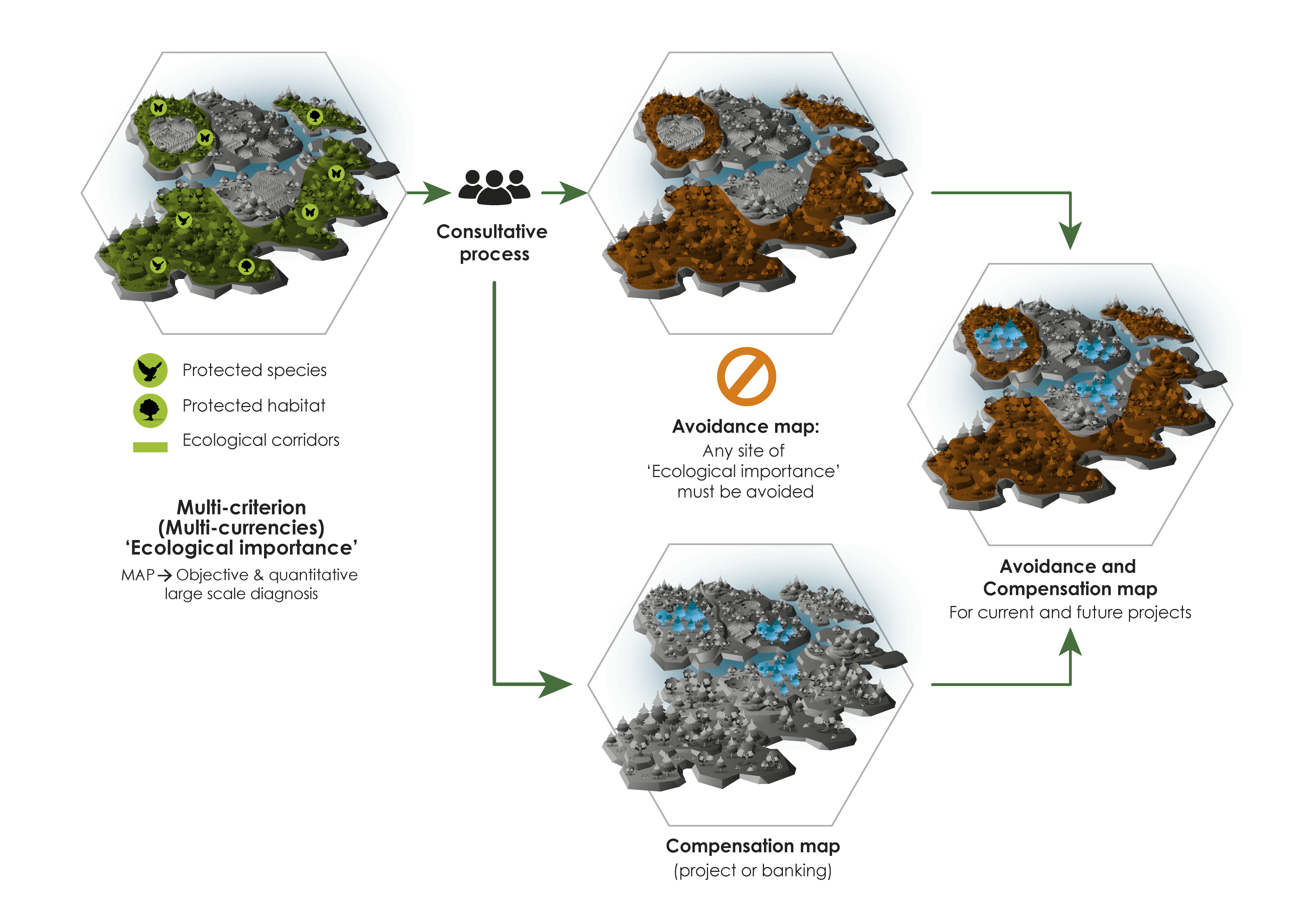Similar to the avoidance step, anticipation of, and planning offset measures at a strategic level can be a powerful approach to fully implement the mitigation hierarchy successfully. Two different but complementary approaches exist to carry out this planning, either a compensation strategy within a spatialised master plan or the use of conservation banking.
Master plan for compensation strategy
In the context of infrastructure development, strategic planning is fundamental to identify the conflicts between biodiversity conservation and infrastructure development (see Chapter 2 – Policy, strategy and planning). Moreover, the integration of infrastructure design in a master plan can take a wide range of directions, from the assessment of impacts to the development of synergistic strategies for human development and biodiversity conservation. Infrastructure designers can include their projects and their compensation needs in these master plans. The scale of study associated with the master plan facilities this strategic approach, as discussed in Chapter 4 – Integration of infrastructure into the landscape concerning integration of infrastructure within the landscape.
A consultation process regarding compensation must commence at the earliest steps of design, to fully integrate biodiversity considerations in the projects within the local master plan. By doing so, not only does the developer improve the acceptability of the project and its ecological integration, but work can also commence and integrate compensation measures aligned with the local conservation strategy. This link between the developer and the local authority is a strong lever for a better implementation of compensation measures. Among other benefits, site management can be coordinated, land use conflicts reduced, and an appropriate roadmap can be developed for effective implementation and monitoring.
Such an integration requires different conditions to be met, not all of them in the hands of infrastructure designers. The integration of offset measures in a master plan requires that this type of consideration actually exists in the master plan. If the use of master plan for avoidance rests only on an ecological diagnostic evaluation of the territory, offset measures need to be based on an initial definition of conservation targets for the area and a pre-identification of the potential for restoration. This planning must be established by the local authorities. However, considering the scale of impacts/benefits an infrastructure can have on a territory, designers may have an influence on local authorities which helps facilitate this planning.
Pre-identification enables the local authority to start ecological management of land they own to generate biodiversity gains by anticipation of future NNLs. These NGs will then be assessed against equivalent losses, considering the principles of equivalence, proximity, and additionality. For infrastructure developers, this work guides them in limiting the discussions only to the representatives in the areas crossed by the infrastructure, to guarantee the efficiency of the offset strategy as well as the longevity of its measures. In the metropolitan area of Nimes, France, for example, an avoidance strategy was developed with a conservation strategy supporting offset measures. Opportunities for compensation were found following a consultation process undertaken as part of the avoidance step in the mitigation hierarchy, where measures to avoid impacts were designed with the stakeholders. On the basis of an ecological diagnosis, local experts, representing local authorities and development stakeholders, defined the areas that should be prioritised for restoration to reach the territory’s biodiversity targets (Figure 3.4.1). Once this first consultation work was established, the local authority could identify public land that could be managed to generate ecological gains.

Offset banking
Offset banking is an alternative option to provide compensation on demand. An operator produces and justifies ecological gains at their location and sells these to any developers in need of offset for NNLs within their own projects. Conservation banking has received a lot of interest from the academic community worldwide. There are various examples of application especially in the United States, whilst in Europe, particularly Germany and France, integrated compensation banking has been implemented as part of the mitigation hierarchy.
In Germany, mutual compensation has been available for landowners since the 1990s for unprotected biodiversity. Under the control of the regional authorities, any landowner can implement favourable ecological management that generates ‘eco-points’ which will be accumulated within an Ökokonto or ‘Ecological account’. Developers are responsible for calculating the quantity of eco-points lost due to a project and they can then purchase replacement points, in a like-for-like equivalence. This framework is designed to reach a NNL objective according to the German legislation, but only for unprotected species and habitats. This mutual compensation has multiple benefits for the infrastructure designer because acceptability of offset measures is taken care of earlier, the efficiency and success of compensation measure is guaranteed, as is their continuity. The implementation of the Ökokonto is anticipated around urban development projects and is supported by the local master plan, increasing the chances of success of measures.
In France, a similar approach has been under development since 2016 with the integration of the Sites Naturels de Compensation within the law. This compensation banking is based on the implementation of ecological restoration by a compensation operator which justifies ecological gains to authorities. The NGs are translated into compensation units that can be sold to any developers to offset like-for-like equivalent impacts in an affected area. This system is still very new in its operative context. Some challenges are that it needs to include the justification of ecological benefits in the initial declaration and the price of the compensation units.